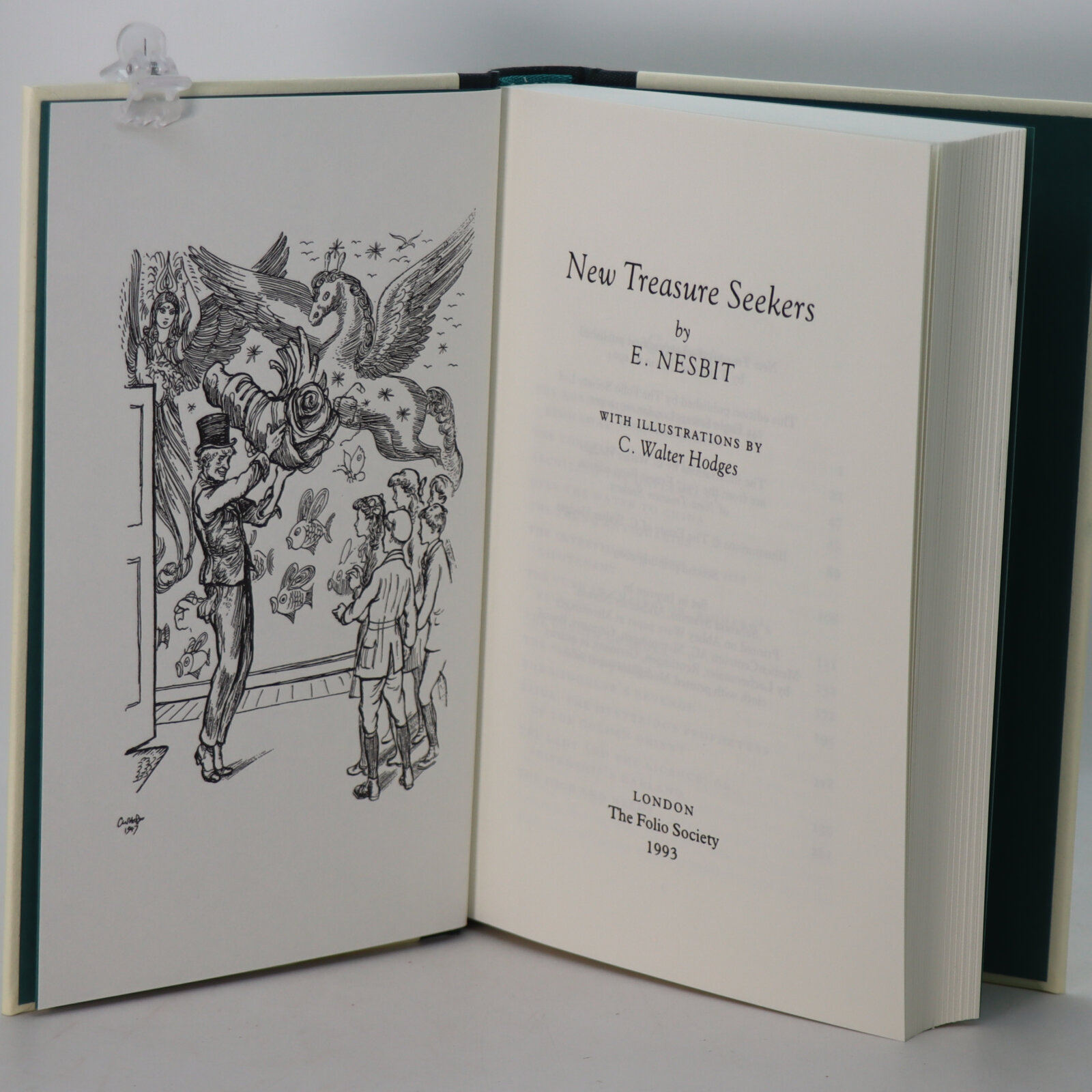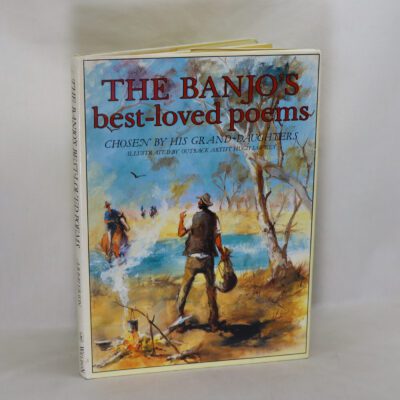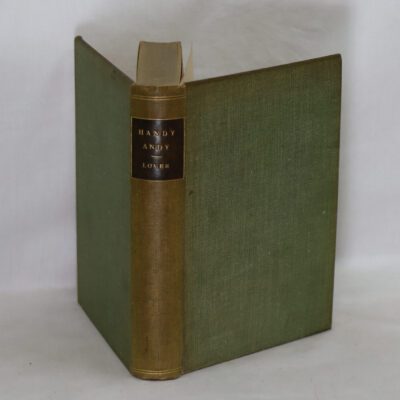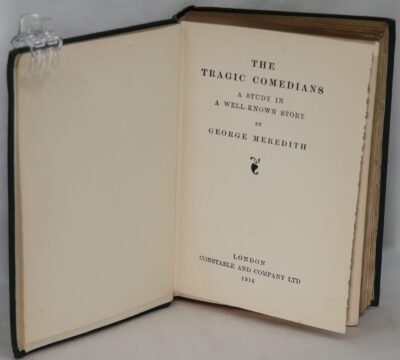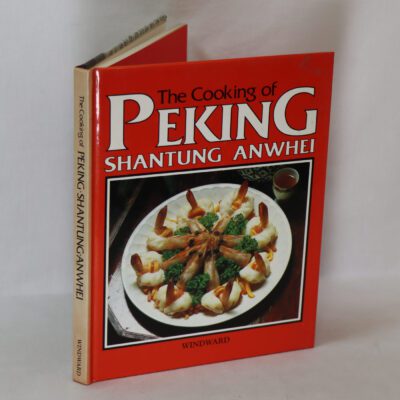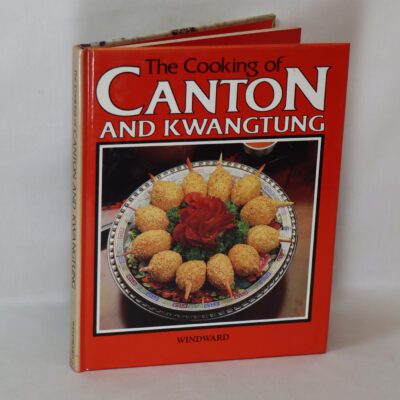The Adventures of the Treasure Seekers. 3 Volume Boxed Set.
By E Nesbit
ISBN: 9798655854024
Printed: 2009
Publisher: The Folio Society. London
| Dimensions | 15 × 21 × 9 cm |
|---|---|
| Language |
Language: English
Size (cminches): 15 x 21 x 9
Condition: Fine (See explanation of ratings)
Your items
Item information
Description
In a matching fitted box. Green cloth spines with gilt titles. Cream boards with brown title and story illustrations.
F.B.A. provides an in-depth photographic presentation of this item to stimulate your feeling and touch. More traditional book descriptions are immediately available.
This book needs to be put in Folio & Franklin Library Books, Adventure Books, Novel, Children’s Books, and English Material Books categories
Endorsed by F.B.A. – F.B.A. is endorsing a range of collectable lovingly used books
A very collectable set
Three volumes: 1. The Story of the Treasure Seekers – Being the Adventures of the Bastable Children in Search of a Fortune; 2. The Wouldbegoods – Being the Further Adventures of the Treasure Seekers; 3. New Treasure Seekers.
The Story of the Treasure Seekers is a novel by E. Nesbit first published in 1899. It tells the story of Dora, Oswald, Dicky, Alice, Noel, and Horace Octavius (H. O.) Bastable, and their attempts to assist their widowed father and recover the fortunes of their family. The novel’s complete name is The Story of the Treasure Seekers: Being the Adventures of the Bastable Children in Search of a Fortune. The original edition included illustrations by H. R. Millar. The Puffin edition (1958) was illustrated by Cecil Leslie. Its sequels are The Wouldbegoods (1901) and The New Treasure Seekers (1904). The story is told from a child’s point of view. The narrator is Oswald, but on the first page he announces:
“It is one of us that tells this story – but I shall not tell you which: only at the very end perhaps I will. While the story is going on you may be trying to guess, only I bet you don’t.”
However, his occasional lapse into first person, and the undue praise he likes to heap on himself, makes his identity obvious to the attentive reader long before he reveals it himself. The Bastables stories from The Story of the Treasure Seekers were first published between 1894 and October 1899 in an assortment of periodicals: Nister’s Holiday Annual, the Illustrated London News and its supplement Father Christmas, The Pall Mall Magazine, and the Windsor Magazine. The order in which the chapters appeared was changed for the one-volume publication in 1899. Some of them also underwent extensive rewriting.
The Story of the Treasure Seekers was the first novel for children by E. Nesbit. This and her later novels exerted considerable influence on subsequent English children’s literature, most notably Arthur Ransome’s books and C. S. Lewis’ The Chronicles of Narnia. Lewis notes in the first chapter of The Magician’s Nephew that the portion of the action of that book that takes place in this world happens at the same time as that of the Treasure Seekers. The American writer Edward Eager was also influenced by this and other Nesbit books, most notably in his Half Magic series, where he mentions the Bastable children and other Nesbit characters as heroes of his characters.
Nesbit’s influence on other British and American children’s literature rests largely on the following motifs: her protagonists are a set or sets of siblings from a separated or incomplete family. The events of the story take place while the children are isolated as a group, for example, while on holiday. Through magic or complex imaginative play, the children face perils that they overcome through pluck. Another notable feature is the depiction of the realistic quarrels and faults of the children. J. K. Rowling, writer of Harry Potter, ranked Nesbit as one of her favourite authors, and The Story of the Treasure Seekers as her favourite of Nesbit’s books.
British writer Michael Moorcock later used the character, or at least the name, of Oswald Bastable for the hero and first-person narrator of his trilogy A Nomad of the Time Streams, published from 1971 until 1981, an influence on the nascent genre of steampunk.
Edith Nesbit (married name Edith Bland; 15 August 1858 – 4 May 1924) was an English writer and poet, who published her books for children as E. Nesbit. She wrote or collaborated on more than 60 such books. She was also a political activist and co-founder of the Fabian Society, a socialist organisation later affiliated to the Labour Party. Nesbit’s first published works were poems. She was under 20 in March 1878, when the monthly magazine Good Words printed her poem “Under the Trees”. In all she published about 40 books for children, including novels, storybooks and picture books. She also published almost as many books jointly with others.
Nesbit’s biographer, Julia Briggs, names her “the first modern writer for children”, who “helped to reverse the great tradition of children’s literature inaugurated by Lewis Carroll, George MacDonald and Kenneth Grahame, in turning away from their secondary worlds to the tough truths to be won from encounters with things-as-they-are, previously the province of adult novels”. Briggs also credits Nesbit with inventing the children’s adventure story. Noël Coward was an admirer. In a letter to an early biographer, Noel Streatfeild wrote, “She had an economy of phrase and an unparalleled talent for evoking hot summer days in the English countryside.”
Among Nesbit’s best-known books are The Story of the Treasure Seekers (1899) and The Wouldbegoods (1901), which tell of the Bastables, a middle-class family fallen on relatively hard times. The Railway Children is also popularised by a 1970 film version. Gore Vidal called the time-travel book, The Story of the Amulet, one where “Nesbit’s powers of invention are at their best.” Her children’s writing also included plays and collections of verse.
Nesbit has been cited as the creator of modern children’s fantasy. Her innovations placed realistic contemporary children in real-world settings with magical objects (which would now be classed as contemporary fantasy) and adventures and sometimes travel to fantastic worlds. This influenced directly or indirectly many later writers, including P. L. Travers (of Mary Poppins), Edward Eager, Diana Wynne Jones and J. K. Rowling. C. S. Lewis too paid heed to her in the Narnia series and mentions the Bastable children in The Magician’s Nephew. Michael Moorcock later wrote a series of steampunk novels around an adult Oswald Bastable of The Treasure Seekers. In 2012, Jacqueline Wilson wrote a sequel to the Psammead trilogy: Four Children and It. Nesbit also wrote for adults, including eleven novels, short stories, and four collections of horror stories. In 2011, Nesbit was accused of plagiarising the plot of The Railway Children from The House by the Railway by Ada J. Graves. The Telegraph reported that the Graves book had appeared in 1896, nine years before The Railway Children, and listed similarities between them. However, not all sources agree on this finding: The magazine Tor.com posited an error in the earlier news reports, saying both books had been released in the same year, 1906.
In The New Yorker, Jessica Winter has noted that Nesbit’s books are at times “blighted by racist and colonialist language and anti-Semitic tropes.” Although she was the family breadwinner and has the father in The Railway Children declare that “Girls are just as clever as boys, and don’t you forget it!,” she did not champion women’s rights. “She opposed the cause of women’s suffrage—mainly, she claimed, because women could swing Tory, thus harming the Socialist cause.” In 2022, nearly a century after her death, The Railway Children (HarperCollins Children’s Classics) and The House of Arden (New York Review Children’s Collection) were reissued. She is said to have avoided the literary moralizing that characterized the age. “And, most crucially, both books are constructed from a blueprint that is also a kind of re-enactment of the author’s own childhood: an idyll torn up at its roots by the exigencies of illness, loss, and grief.”
Want to know more about this item?

Share this Page with a friend



